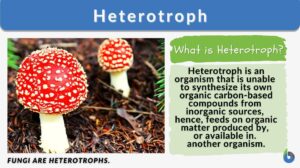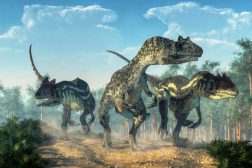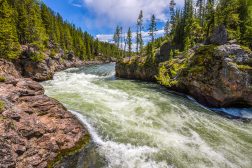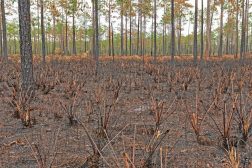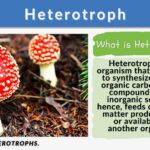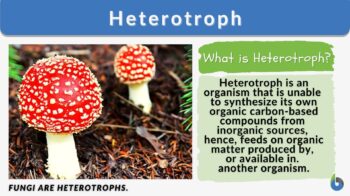
Heterotroph
n., plural: heterotrophs
[ˈhɛtəɹoʊˈtɹoʊf]
Definition:
An organism that feeds on organic matter produced by, or available in, other organisms.
Table of Contents
Heterotroph Definition
What is a heterotroph? Does a heterotroph make its own food? In biology and ecology, a heterotroph is an organism that does not have the ability to chemically produce (i.e. synthesize) its own food from inorganic molecules. Because of this inability, heterotroph feeds on other forms of life to derive their organic nutritional requirements. (Ref. 1) A heterotroph can also be defined based on the chemistry of the food it uses to survive. In particular, an organism is a heterotroph if it obtains its nutrition from organic compounds (i.e. complex molecules found in living things).
Generally, these organic compounds are used by the heterotroph to obtain energy for their own survival. These organic compounds are used by heterotrophs to form important biomolecules, such as simple sugars, carbohydrates (i.e. complex sugars), fats (also known as lipids), proteins (which are broken down during digestion into amino acids), and nucleic acids (i.e. DNA and RNA). They incorporate these biomolecules into their body to perform all the metabolic functions necessary for survival and reproduction.
A heterotroph is an organism that cannot make its own food; it is unable to synthesize its own organic carbon-based compounds from inorganic sources and as a result, they feed on organic matter produced by, or available in, other organisms.
Etymology: from Greek “héteros”, meaning “different” + “trophos”, meaning “feeder”.
Related terms: heterotrophy (noun), heterotrophic (adjective), heterotrophically (adverb).
Synonym: consumer
Compare: autotroph, phototroph
The word heterotroph gives origin to certain words:
- Heterotrophy (noun)
The condition of being a heterotroph is called heterotrophy. For example: “A right whale, one of the largest creatures in the ocean, exhibits heterotrophy. It feeds on plankton, some of the smallest organisms in the ocean”. - Heterotrophism (noun)
What is heterotrophism? Is it the same as heterotrophy? Heterotrophism refers to the ability of an organism for a life of heterotrophy. - Heterotrophic (adjective)
By definition, this term is used to describe an organism eating other organisms. For example: “Some bacteria are heterotrophic — meaning the heterotrophic bacteria will feed on other types of bacteria for nourishment”. - Heterotrophically (adverb)
Feeding heterotrophically means feeding on other organisms. For example: “A shark feeds heterotrophically near the Barrier Reef. It hunts fish and other marine life and is a very efficient predator”.
Types of Heterotrophs
What are the different types of heterotrophs? Let us find out the answer to that question below.
Photoheterotrophs vs. chemoheterotrophs
Heterotrophs consume other organisms to get their energy to survive, that is they obtain their carbon from organic compounds. They may be classified into two major groups: (1) photoheterotrophs and (2) chemoheterotrophs. Basically, photoheterotrophs use light energy whereas chemoheterotrophs do not. Rather, the latter derive their energy from inorganic oxidation.
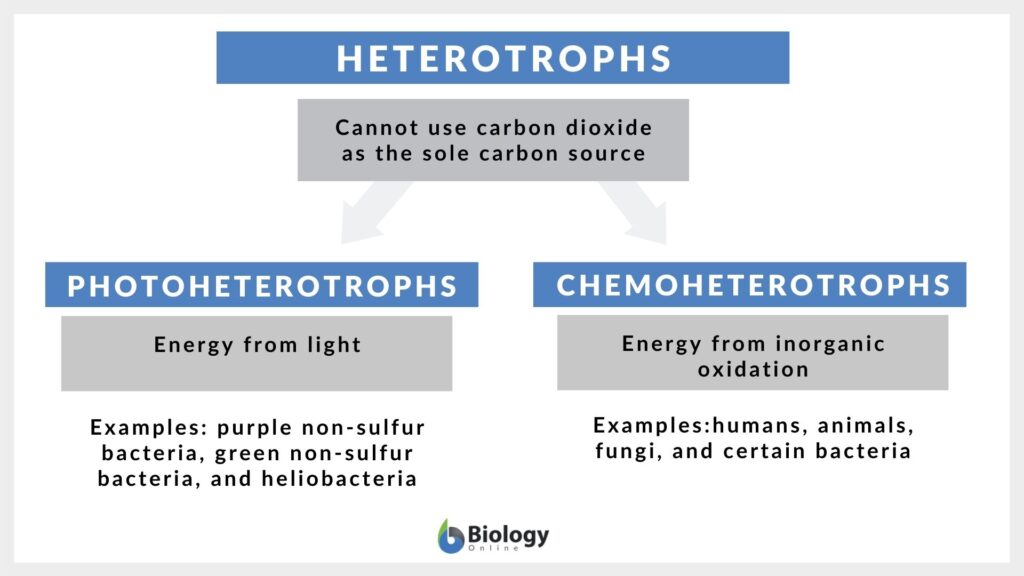
Photoheterotrophs are heterotrophs that use energy from sunlight, but just as supplemental energy (i.e. extra energy). In fact, carbon dioxide is not their only source of energy. They use carbon from other forms of life, meaning, they feed on other organisms as well. Some examples of photoheterotrophs are found in the world of bacteria such as various forms of non-sulfur bacteria, and heliobacteria. There are also insects, in particular aphids, and a type of wasp (the Oriental Hornet or Vespa orientalis) that are also able to use the energy of the sun as a supplement to their regular food.
Chemoheterotrophs, such as humans and other animals, are the more classic heterotrophs. They get their energy from chemicals that they acquire by eating other forms of life exclusively.
Organotrophs vs. lithotrophs
Another way of grouping heterotrophs is by the type of compounds they use as electron sources. Organotrophs, in particular, are heterotrophs that use reduced carbon compounds, e.g. carbohydrates, fats, and proteins. In contrast, lithotrophs are heterotrophs that use inorganic compounds (e.g. ammonium, nitrite, or sulfur) as electron sources.
Chemoorganoheterotrophs
Chemoorganoheterotrophs are heterotrophs characterized by the following features:
- Organic carbon (e.g. glucose) is used as a carbon source
- Organic compounds (e.g. carbohydrates, proteins, and lipids) are used as an electron source
Many heterotrophs fall under this particular type of heterotroph.
Heterotrophs vs. Autotrophs
What is the difference between autotrophs and heterotrophs? In essence, autotrophs are organisms capable of making nutritive organic molecules from inorganic materials. Thus, they differ from heterotrophs in having the capability of producing their own food and need not consume other organisms for sustenance. They can produce complex organic compounds from inorganic substances generally in two ways, i.e. by photosynthesis or by chemosynthesis. Heterotrophs lack this capability and therefore have to feed on other organisms.
Examples of autotrophs are land plants, lichens, photosynthetic algae (e.g. chlorophytes, charophytes, dinoflagellates, and diatoms), and photosynthetic bacteria (e.g. cyanobacteria). These organisms employ photosynthesis in producing organic compounds from inorganic sources. They are referred to specifically as photoautotrophs. Another group of autotrophs is the chemoautotrophs. This group consists of autotrophs that use chemical energy in producing complex organic compounds. Examples include methanogens, halophiles, nitrifiers, thermoacidophiles, and sulfur oxidizers.
For further comparison between heterotrophs and autotrophs, see this table below:
| Heterotrophs | Autotrophs |
|---|---|
| Definition: Organisms that are unable to synthesize their own organic carbon-based compounds from inorganic sources, hence, have to feed on organic matter produced by, or available in, other organisms | Definition: Organisms capable of making nutritive organic molecules from inorganic materials |
| Consumers in the Ecological Pyramid | Producers in the Ecological Pyramid |
| Types: Photoheterotrophs and Chemoheterotrophs | Types: Photoautotrophs and Chemoautotrophs |
| Examples: humans, animals, fungi, various protists, and some bacteria | Examples: plants, photosynthetic algae, photosynthetic bacteria, methanogens, halophiles, nitrifiers, thermoacidophiles, and sulfur oxidizers |
The Role of Heterotrophs in the Ecosystem
Why are heterotrophs important to the ecosystem? Heterotrophs are the consumers in the food chain or food web, meaning they consume other forms of life. They are not capable of producing their own food, unlike the producers. Heterotrophs are found at all levels of the food chain in a particular environment, and each level plays a critical role in the ecology of that environment.
Some heterotrophs are primary consumers and are also known as herbivores. They eat the autotrophic plants and/or other organisms capable of manufacturing their own food, such as phytoplankton and photosynthetic bacteria. Some examples of herbivores or primary consumers are a deer in a forest, an elephant in an African savannah, a manatee on a seagrass bed in Florida, a snail in a tropical forest, or a sea snail on a coral reef.
Some heterotrophs are secondary consumers and are also known as carnivores, or meat-eaters because they eat other heterotrophs. Examples of secondary consumers are a wolf in a forest eating a deer, a pride of lions in an African savannah eating an elephant, a shark eating a manatee in the Florida Keys, a salamander, and a toad, both eating snails in the rainforest, or a Giant Triton (a giant marine snail) eating other sea snails on a coral reef. These are secondary consumers when they eat primary consumers.
Some secondary consumers can also be tertiary consumers or top predators, meaning they can eat both primary consumers and other secondary consumers such as themselves. Examples of top predators are wolves, which not only can eat deer but can also eat a fox (a carnivore itself), for example. Lions and leopards in the African savannah can also eat crocodiles, or lizards, or other carnivores. A shark can eat fish, some of which are themselves carnivores. Orcas are a top predator in the ocean, and they can eat sharks as well as fish. An eagle or a hawk are examples of top predators in the bird world. A Crown-of-Thorn sea star is a top predator on a coral reef. Humans are top predators as well.
Some heterotrophs are omnivores and eat both primary producers and other heterotrophs like themselves.
Are all animals heterotrophs? We can say that all animals are heterotrophs but the type varies depending on what they preferably eat. Most herbivores only eat plants and other photosynthetic autotrophs and never eat other animals. Some can be both primary consumers and secondary consumers. Think of a bear, for example. Bears can eat fruits and vegetables, but can also eat other animals. Humans are the same.
Are humans heterotrophs? Humans are heterotrophs and many of us are omnivores. We eat a variety of plants and animals.
By eating other organisms in the food chain, heterotrophs recycle nutrients and organic chemicals and put them to good use in their body, or defecate and, therefore, help seeds of a variety of plants germinate and spread to other areas of an ecosystem. Some plant seeds need to pass through the digestive system of a heterotroph, or consumer, to germinate (this process is called scarification, and it is the process that weakens the coat of the seed so that the plant embryo can emerge). Heterotrophs also fertilize the land and/or the water with their feces.
Consumers or predators are very important ecologically because they keep the populations of their prey within reasonable numbers. For example, a review of research studies by Ballard et al. (2001) suggested that coyotes, mountain lions, and wolves play a major role in determining the size of deer populations in the United States. A classic thirty-year study in Isle Royale, Michigan (Page 1990) clearly showed how predators (wolves in this case) and prey (moose) interact. The size of a wolf pack is determined by how many moose are available in a particular area. If the moose population increases, then the size of the wolf pack can increase and vice-versa.
Also, predators tend to eat older and weaker individuals or the ones that are less able to survive and, by doing so, keep the population of their prey healthier. In many places where predators have been hunted and eliminated, ecosystems are unhealthy. For example, in the United States, deer populations have exploded in many areas because wolves, coyotes, and other natural predators have disappeared. This causes overpopulation, which results in overgrazing (i.e. eating too much vegetation) creating erosion and barren landscapes. Too many individuals in a population are more prone to spread diseases as unhealthy individuals are not eliminated by a predator.
Heterotroph Examples
What is an example of a heterotroph? And which kind of organism is a heterotroph? All non-autotrophic are heterotrophs. They are exemplified by animals, fungi, various protists, and some bacteria. Therefore, heterotrophs can be multicellular (i.e. made of many cells) or unicellular (i.e. made of only one cell).
We already cited various animals that play a role as heterotrophs in an ecosystem. Refer to the previous section for specific examples of animals as heterotrophs: The Role of Heterotrophs in the Ecosystem.
Are fungi autotrophs or heterotrophs? Fungi are heterotrophic. These organisms are plant-like in having cell walls but they lack chlorophyll (green pigment essential in photosynthesis).
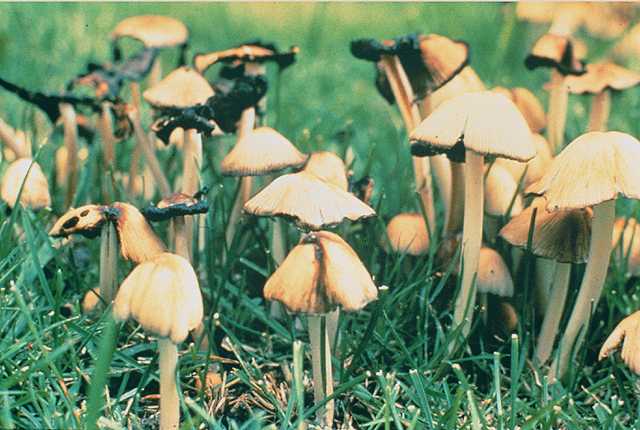
Protists (Kingdom Protista) that are heterotrophs include protozoans, certain nonphotosynthetic algae, water molds, and slime molds. There is such a variety of these Protists that entire books have been dedicated to describing them and many existing species have probably not yet been discovered (Ref. 2). Ameoba is just one of them. Watch the video below to see how an amoeba catches and eats its prey, paramecia (a ciliate protozoan).
Many bacteria are heterotrophs. Examples are Escherichia coli, commonly found in feces, and many bacteria on our skin, in water bodies, and in a variety of other habitats. An interesting group of bacteria is the microbe-eating microbes. These bacteria eat other bacteria. Below is a video of a bacterium (Bdellovibrio) that attacks and feeds on another bacterium (E. coli).
Carnivorous plants, such as the Venus flytrap, are not a “full-time” heterotroph. They may be consuming organisms for nutrition but they are still capable of photosynthesis. Thus, we can say that they are facultatively heterotrophic, meaning they are not wholly heterotrophic and may still survive through a photosynthetic mode of life and grow, albeit relatively slower when not resorting to heterotrophy.
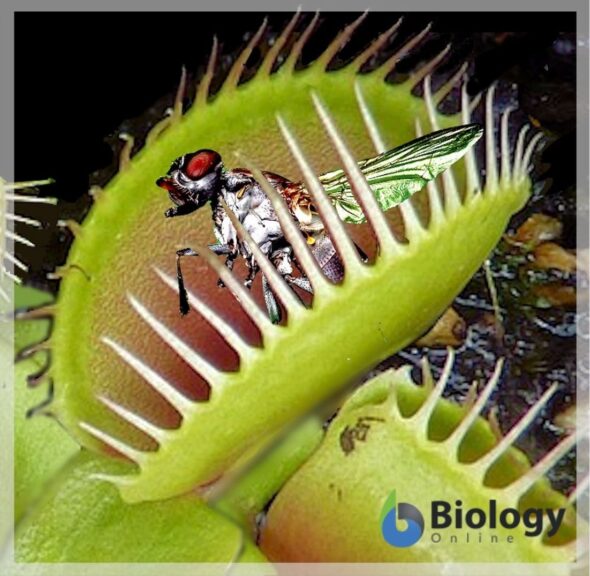
Try to answer the quiz below to check what you have learned so far about heterotrophs.
References
1. Sutton, J. (1998). Heterotrophic Nutrition. In Biology (pp. 349-362). Palgrave, London.
2. Patterson, D. J., & Lee, W. J. (2000). Geographic distribution and diversity of free-living heterotrophic flagellates (pp. 269-287). London, UK: Taylor & Francis Press.
3. Ballard, W. B., Lutz, D., Keegan, T. W., Carpenter, L. H., & deVos Jr, J. C. (2001). Deer-predator relationships: a review of recent North American studies with emphasis on mule and black-tailed deer. Wildlife Society Bulletin, 99-115.
4. Page, R. E. (1990). The inverted pyramid: ecosystem dynamics of wolves and moose on Isle Roya
©BiologyOnline.com. Content provided and moderated by BiologyOnline Editors.

